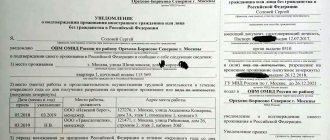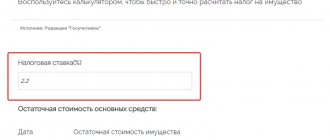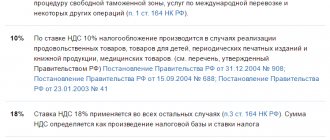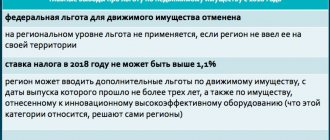Objects of taxation and rates for them
What types of property are subject to property tax for individuals is regulated by Art. 401 of the Tax Code of the Russian Federation. These include:
- House;
- living space (apartment, room);
- garage, parking place;
- single real estate complex;
- unfinished construction project;
- other building, structure, structure, premises.
Note that until 2015, the list looked somewhat different; it included a residential building, apartment, room, cottage, garage, other building, premises and structure (accordingly, parking spaces and unfinished construction objects were not included in this list).
It is worth noting that residential buildings located on land plots for personal subsidiary farming, dacha farming, vegetable gardening, gardening, individual housing construction are classified as residential buildings, while property included in the common property of an apartment building will not be subject to taxation.
Residential buildings and premises, as well as objects of unfinished construction of residential buildings and unified real estate complexes, which include at least one residential premises, are taxed at a rate of 0.1%.
The same rate applies to garages and parking spaces, as well as outbuildings or structures with an area of no more than 50 m2, which are located on land plots provided for personal farming, dacha farming, vegetable gardening, horticulture or individual housing construction.
Thus, even if there is a non-residential premises with an area of less than 50 m2 on the dacha plot, it will be taxed at the same rate as residential premises. In addition, such premises and structures often have different benefits depending on the region.
Tax rates, also depending on the region, can be reduced to zero or increased, but not more than three times. This may depend, in particular, on the cadastral value of the property, and also vary depending on the tax period. For example, in Moscow the rates will be as follows:
| Cadastral value of an apartment/room/residential building | Tax rate |
| up to 10 million rubles | 0,1% |
| from 10 to 20 million rubles. | 0,15% |
| from 20 to 50 million rubles. | 0,2% |
| from 50 to 300 million rubles. | 0,3% |
In Moscow, rates also vary depending on whether the object of taxation (premises) is located in an office and/or retail facility or not. Thus, for tax objects located in office and retail facilities, the following rates are provided:
| for tax for 2015 (payable in 2021) | 1,2% |
| for tax for 2021 (payable in 2021) | 1,3% |
| for tax for 2021 (payable in 2021) | 1,4% |
| for taxes for 2021 and subsequent years (payable in 2021 and beyond) | 1,5% |
The full list of retail and office facilities in Moscow was approved by Decree of the Moscow Government dated November 28, 2014 No. 700-PP.
The rate for garages and parking spaces in Moscow remains 0.1%, for unfinished private residential buildings - 0.3%.
In addition, for any real estate with a cadastral value of more than 300 million rubles. the rate will be 2%, not only in Moscow, but also in all other regions.
In all other cases (for example, for warehouses or industrial buildings) the rate of 0.5% will apply.
In some municipalities of the constituent entities of the Russian Federation, until 2021, the tax is calculated on the basis of inventory value rather than cadastral value. In this case, tax rates are set based on the total inventory value of the objects, multiplied by a deflator coefficient.
| The total inventory value of taxable objects, multiplied by a deflator coefficient (taking into account the taxpayer’s share in the right of common ownership of each of such objects) | Tax rate |
| Up to 300,000 rubles inclusive | up to 0.1% |
| From 300,000 to 500,000 rubles inclusive | from 0.1 to 0.3% |
| From 500,000 rubles | from 0.3 to 2% |
In general, the tax calculation formula is as follows:
Tax amount for 2021 = (KSr * C - N2017) * K + N2017
CSR = cadastral value taking into account tax deduction = cadastral value - (cadastral value/area of the object) * amount of deduction; C - tax rate; K - reduction factor; N2017 - tax amount for 2021.
It would seem like a fairly simple formula and clear rules. However, in practice, disputes constantly arise about the classification of a particular object into different categories (which, in turn, affects the applicable tax rate). Thus, in 2021, heated debates were caused by outbuildings on plots provided for personal subsidiary plots, dacha farming, vegetable gardening and horticulture, or individual housing construction - that is, in a garden or in a dacha. The fact is that in the current Tax Code of the Russian Federation there are no definitions of the concepts “economic structure” and “economic structure”.
So the Russian Ministry of Finance had to look into this issue. In a letter dated May 16, 2017 No. 03-05-04-01/29325, referring to the laws of July 7, 2003 No. 112-FZ “On personal subsidiary plots” and dated April 15, 1998 No. 66-FZ “On horticultural, gardening and summer cottages” non-profit associations of citizens" the Ministry of Finance established that on land plots provided for running personal subsidiary plots, it is planned to erect a residential building, industrial, household and other buildings, structures, structures, including buildings and structures for auxiliary use.
The Ministry of Finance especially emphasized that in cadastral registration such structures can be either named (bathhouse, kitchen, barn) or simply called “economic building.” This circumstance cannot influence taxation, as well as the application of tax benefits.
So you don’t have to pay tax for country bathhouses and sheds: unless their area is more than 50 m2, they are subject to the corresponding benefit. But it is important that the benefit can only be applied to one building, even if several buildings are located in different regions of the Russian Federation.
But non-permanent buildings, including greenhouses and sheds, are not registered as real estate at all, and therefore cannot be subject to tax. Moreover, in each subject of the Russian Federation, a register of land plots with houses and outbuildings with an area of over 50 m2 is created, for which ownership is not registered. If the register mistakenly includes sheds, greenhouses, wells, sheds and other outbuildings that are not capital objects construction and taxation, they are excluded from the list. The lists of real estate properties themselves can be found on the websites of regional ministries of property relations and regional government service portals.
It is also important that houses on garden plots are still classified as residential premises and are taxed accordingly. A similar approach is used in relation to garages located on garden plots - they are also perceived by the tax authorities as ordinary garages.
Also still a controversial topic are residential buildings, which are “assembled” from timber and theoretically can be disassembled for moving to another location. The rights to thousands of such houses are registered in the Unified State Register of Real Estate, but recent judicial practice shows that the criteria of the Civil Code of the Russian Federation on an inextricable connection with the land can be applied to them. In case No. A51-40899/2013, the court of first instance came to the conclusion that wooden houses do not have the properties of real estate; the appellate court confirmed these conclusions.
And since such houses qualify as
“a non-permanent, prefabricated object, the internal and external walls of this object are made of profiled laminated veneer lumber with a cross section of 230×170 mm from coniferous trees, designed and manufactured in a factory by Siberian Terema LLC as prefabricated and collapsible structures, ... which are placed on a monolithic slab (concrete preparation) with a thickness (t) of up to 0.3 (30 cm), part of the building is placed on wooden poles and struts, on the back and left end side, part of the external walls is made of “SIP” type panels, which are partially installed on a monolithic slab (preparation) and directly onto the surface of the earth (including onto a leveling layer of rocky soil); interfloor and attic floors are wooden, internal stairs are wooden, a gable roof made of metal tiles on a base of wooden structures; there is no interior decoration of the ceiling and walls; filling wooden and window openings - plastic window and door structures" (Decision of the Arbitration Court of the Primorsky Territory in case No. A51-40899/2013 dated 08/11/2017),
they, according to Art. 130 of the Civil Code of the Russian Federation, are not real estate. However, the case is not over yet, and we are looking forward to the outcome of its consideration in the cassation court.
Where can I find out about cadastral valuation?
Finding out the amount of the new tax on your own property is relatively simple, and you don’t have to wait for the receipt to arrive. To do this, you just need to go to the special website of the tax service, find there a list of taxable objects with an estimated cadastral value, and then find in it the price for your home. You won’t be able to figure out the nuances right away, because it will take time, but after a while the site becomes very convenient and by clicking on the address of a particular property, you can get a full cadastral valuation of the property.
A little about tax deductions and benefits
It is immediately necessary to emphasize the information that from 2021 the real estate tax for simplified tax system will have a slightly different calculation principle, but the value of real estate of people under the simplified tax system will not change dramatically. They will also receive receipts based on the cadastral value of the taxable property, although previously it was believed that they would receive receipts calculated in accordance with the market price.
Tax deductions have remained unchanged since 2015, so it is worth taking into account the fact that taxpayers may not pay for 10 square meters of a privatized private room in an apartment, 20 square meters if the apartment is privatized and belongs to one owner. Owners of outbuildings can count on a deduction of 50 square meters.
It is impossible not to mention separately that property tax benefits in 2021 in Russia will remain the same and will not undergo any changes, although the issue of canceling some preferential positions (due to the developing crisis) was previously discussed. Preferential tax conditions are provided to labor veterans, people who were involved in the liquidation of the Chernobyl accident, as well as disabled people and pensioners. Pensioners should be discussed separately, because the new bill provides benefits for citizens of a given territory only for one piece of real estate. If a pensioner owns, for example, several houses or apartments, he may not pay tax at all on only one object, and all others are paid in full, which allows the authorities to minimize the risk of fraud in the country. However, pensioners still have the opportunity to choose which property they don’t have to pay for, so they can choose the most expensive property and save at least on this.
When talking about benefits, one cannot help but emphasize that the property tax for organizations in 2021 does not provide for preferential deductions, and now business owners will not be able to make pensioners nominal owners of real estate, because they will not be able to save much on this, which means cheating when paying taxes It will become much more difficult for them.
Procedure for paying property tax for individuals
Individuals pay personal property tax on the basis of a tax notice sent by the tax authority no later than 30 days before the payment is due.
The tax notice indicates the amount of tax, the object of taxation, the tax base, as well as the deadline for paying the tax.
A tax notice can be delivered in person against signature, sent by registered mail, transmitted electronically or through the taxpayer’s personal account. When notice is sent by registered mail, it will be deemed received 6 days from the date of sending the registered mail.
From the date of receipt of the notice, the taxpayer has a month to pay this tax (unless otherwise specified in the notice). Please note that if a recalculation has taken place, the tax payment is carried out within the period specified in the tax notice. In this case, the tax notice must be sent no later than 30 days before the deadline specified in the tax notice.
If property owners do not receive this document a month before the tax payment deadline, the Federal Tax Service of Russia recommends taking the initiative by contacting the inspectorate in person by making an online appointment.
If errors or incorrect data are detected that affect the calculation of tax, taxpayers can notify inspectors in a timely manner - an application form intended for feedback from the tax authority is sent along with the tax notice.
The taxpayer pays tax for no more than three tax periods preceding the year in which the notice was sent to him.
How to calculate property taxes in 2021?
Of course, the first thing worth remembering is that you don’t need to calculate payments for all the square meters that you own. The state determines the minimum area that is considered necessary for living and no one is obliged to pay for it. But everything that exceeds this minimum is already taxed.
Minimum footage not subject to taxes from the Federal Tax Service:
- room: 10 squares;
- apartment: 20 square meters;
- house: 50 square meters.
So we will count according to the difference that results. Accordingly, if you have a small apartment with an area of 27 square meters, we calculate the payment only from seven. And if your house is less than 50 square meters, you don’t need to pay property tax at all.
Now let's calculate if the difference still remains. Let's say you have a two-room apartment with an area of 45 square meters. According to the cadastre, it costs 1.4 million rubles. That is, one square costs approximately 31.1 thousand rubles. The payment must be calculated from 25 square meters (because we immediately deduct 20). It turns out about 777.8 thousand rubles. Now we apply the bet. It differs in different regions, plus there may be municipal surcharges, so for simplicity, we’ll take the base coefficient of 0.1%. So, for the year you will have to pay about 778 rubles in taxes. It doesn't seem like much. Only if the family has an apartment, a garage, or a dacha, an impressive amount can come up. For many, it is completely unrealistic.
Tax deductions for personal property tax
If cadastral value is used to calculate tax, the following tax deductions can be applied:
- for apartments, the cadastral value is reduced by the cadastral value of 20 m2 of the total area of this apartment;
- for rooms, the cadastral value is reduced by the cadastral value of 10 m2 of the area of this room;
- for a residential building, the cadastral value is reduced by the cadastral value of 50 m2 of the total area of this residential building (on dacha plots, for deduction purposes, all residential buildings are equated to residential buildings);
- for a single real estate complex, which includes at least one residential premises (residential building), the cadastral value is reduced by 1 million rubles.
At the same time, the representative bodies of municipalities have the right to increase the amount of these deductions, and during the first 4 years of applying the cadastral value, reducing factors are taken into account.
If the taxpayer owned the corresponding taxable object for an incomplete calendar year, the rules for taking into account months when determining reduction factors will be as follows:
- If your ownership of the property arose before the 15th day of the month inclusive (or if it ceased after the 15th day of the month), then when calculating such a month is perceived by the tax authority as a whole (clause 5 of Article 408 of the Tax Code of the Russian Federation);
- If your ownership of the property arose after the 15th day of the month inclusive (or if it ceased before the 15th day of the month), then such a month is not taken into account in the calculation (clause 5 of Article 408 of the Tax Code of the Russian Federation).
Property tax deductions
Residents pay 13% of the tax base. We will tell you how to calculate the base and tax in the next section. In the meantime, let's list the tax deductions. There are three of them.
- Tax deduction on sale. Minus 1,000,000 rubles from the sale price. Can be used once a year. If you sell property in common ownership, the deduction is distributed in proportion to the share. If joint, by agreement between the owners.
- Accounting for expenses. Minus the amount for which the apartment was bought. To confirm expenses, you need a purchase and sale agreement with a specified amount.
- Tax deduction upon purchase. Minus 260,000 rubles from the price of a new apartment . Valid if you sell an apartment and buy a new one in the same tax period. You can use it once in your life. If a new apartment costs less than 2 million rubles, the deduction will be 13% of its price. If greater than or equal to - 260,000 rubles.
NB! A declaration must be filed for tax deductions and expense credits. They are not produced automatically. Deductions cannot be used together!
Privileges
Property tax benefits are established by each region independently. On the website of the Federal Tax Service there is a section “Reference information on rates and benefits for property taxes”, where you can find the benefits established in your region.
The application form for a tax benefit for personal property tax is also available on the Federal Tax Service website.
A tax benefit is provided only for one object, if this object is not used by the taxpayer for business activities. The use of real estate to organize non-state museums, galleries, and libraries open to the public is not considered entrepreneurial activity in this case. Such real estate can be an apartment or a room, a residential building, a garage or parking space, a room or a creative workshop, an atelier, a studio or other creative premises with an area of no more than 300 m2.
A notification about which benefits the taxpayer has chosen must be submitted to the tax office before November 1 of the year from which the benefit will be applied. Along with the notification, you must provide documents justifying the provision of the benefit. After submitting the notification, it will no longer be possible to change the object for which the benefit is applied.








